NSB203 - Oral Analysis of Medicinal Cannabis and Chronic Pain
VerifiedAdded on 2022/09/30
|8
|1766
|21
Practical Assignment
AI Summary
This assignment presents an oral analysis arguing for the safety and effectiveness of medicinal cannabis in managing chronic pain in adults. The analysis begins with an introduction defining pain and the historical use of cannabis, followed by three key arguments supported by evidence. The first argument highlights cannabis's historical use dating back to 2900 B.C., citing ancient Chinese texts. The second argument references preclinical information supporting cannabis's therapeutic benefits for conditions like osteoarthritis and cancer. The third argument discusses cannabinoids' anticancer properties. The analysis concludes by summarizing the decrease in pain indications observed in patients treated with cannabis and improvements in multiple sclerosis-related muscle spasms. The assignment includes a list of quantitative, qualitative, and other sources to support the arguments, followed by a comprehensive reference list.

Running head: ORAL ANALYSIS
Oral Analysis
Name of the student
Name of the university
Author’s name
Oral Analysis
Name of the student
Name of the university
Author’s name
Paraphrase This Document
Need a fresh take? Get an instant paraphrase of this document with our AI Paraphraser
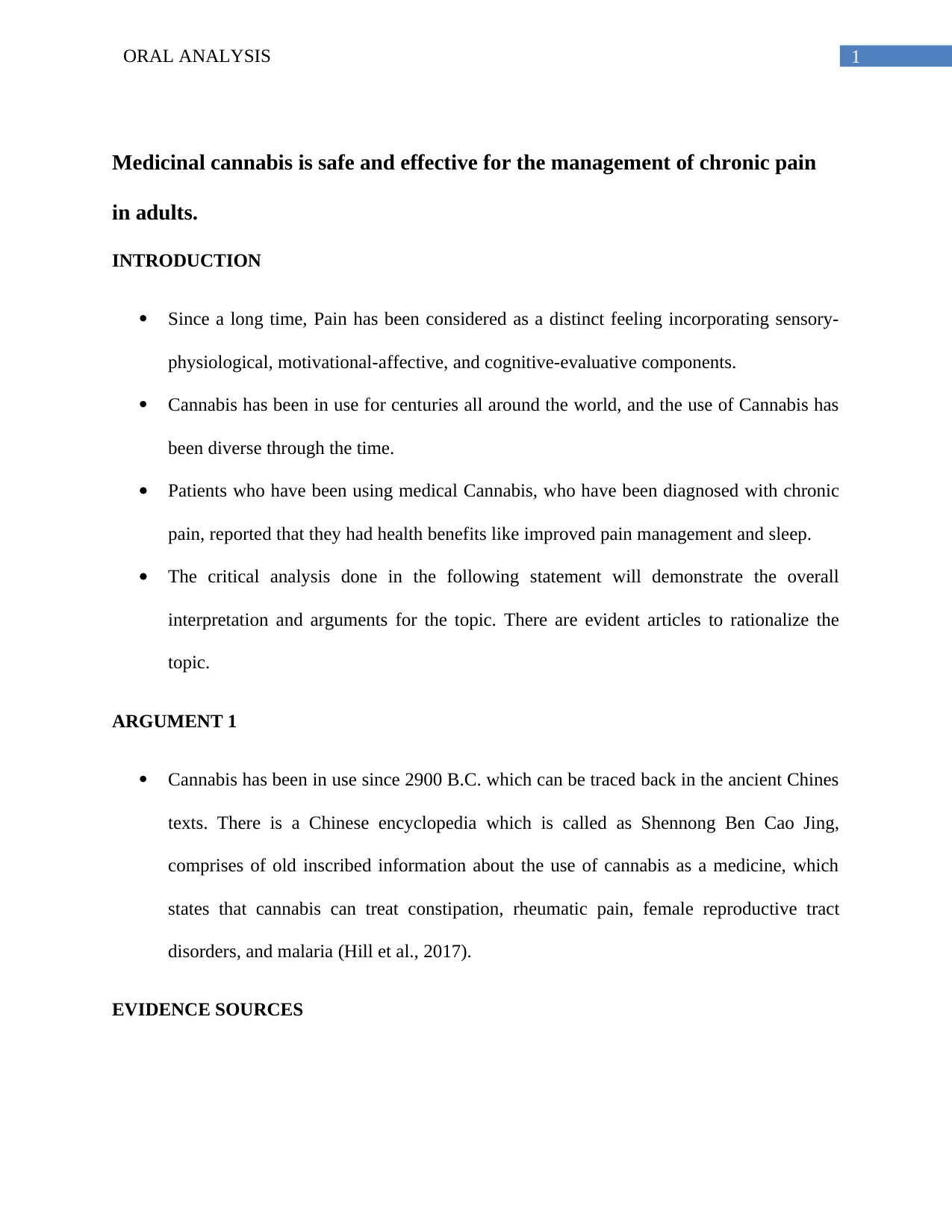
1ORAL ANALYSIS
Medicinal cannabis is safe and effective for the management of chronic pain
in adults.
INTRODUCTION
Since a long time, Pain has been considered as a distinct feeling incorporating sensory-
physiological, motivational-affective, and cognitive-evaluative components.
Cannabis has been in use for centuries all around the world, and the use of Cannabis has
been diverse through the time.
Patients who have been using medical Cannabis, who have been diagnosed with chronic
pain, reported that they had health benefits like improved pain management and sleep.
The critical analysis done in the following statement will demonstrate the overall
interpretation and arguments for the topic. There are evident articles to rationalize the
topic.
ARGUMENT 1
Cannabis has been in use since 2900 B.C. which can be traced back in the ancient Chines
texts. There is a Chinese encyclopedia which is called as Shennong Ben Cao Jing,
comprises of old inscribed information about the use of cannabis as a medicine, which
states that cannabis can treat constipation, rheumatic pain, female reproductive tract
disorders, and malaria (Hill et al., 2017).
EVIDENCE SOURCES
Medicinal cannabis is safe and effective for the management of chronic pain
in adults.
INTRODUCTION
Since a long time, Pain has been considered as a distinct feeling incorporating sensory-
physiological, motivational-affective, and cognitive-evaluative components.
Cannabis has been in use for centuries all around the world, and the use of Cannabis has
been diverse through the time.
Patients who have been using medical Cannabis, who have been diagnosed with chronic
pain, reported that they had health benefits like improved pain management and sleep.
The critical analysis done in the following statement will demonstrate the overall
interpretation and arguments for the topic. There are evident articles to rationalize the
topic.
ARGUMENT 1
Cannabis has been in use since 2900 B.C. which can be traced back in the ancient Chines
texts. There is a Chinese encyclopedia which is called as Shennong Ben Cao Jing,
comprises of old inscribed information about the use of cannabis as a medicine, which
states that cannabis can treat constipation, rheumatic pain, female reproductive tract
disorders, and malaria (Hill et al., 2017).
EVIDENCE SOURCES

2ORAL ANALYSIS
Hill, K. P., Palastro, M. D., Johnson, B., & Ditre, J. W. (2017). Cannabis and pain: a clinical
review. Cannabis and cannabinoid research, 2(1), 96-104.
Hill, K. P., Palastro, M. D., Johnson, B., & Ditre, J. W. (2017). Cannabis and pain: a clinical
review. Cannabis and cannabinoid research, 2(1), 96-104.
⊘ This is a preview!⊘
Do you want full access?
Subscribe today to unlock all pages.

Trusted by 1+ million students worldwide
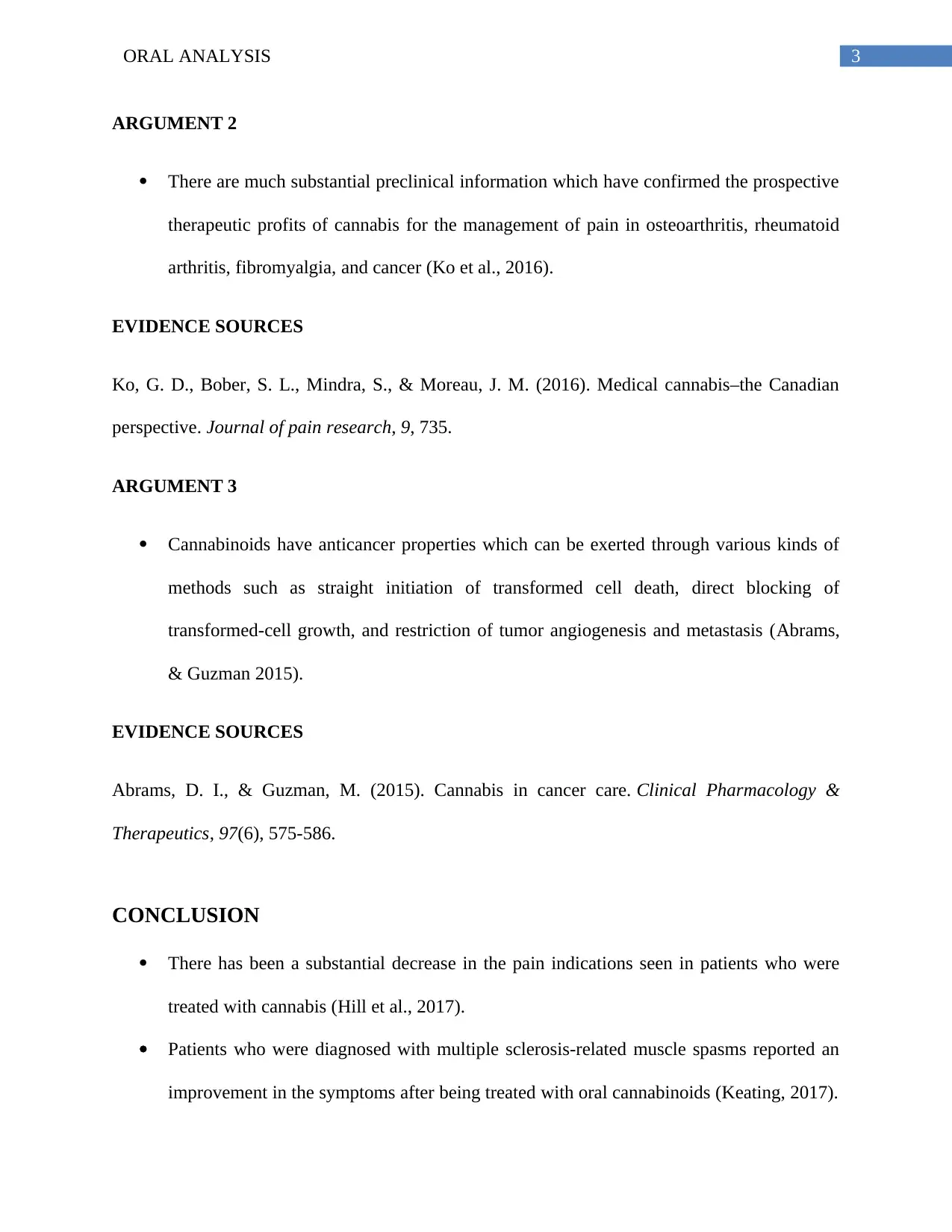
3ORAL ANALYSIS
ARGUMENT 2
There are much substantial preclinical information which have confirmed the prospective
therapeutic profits of cannabis for the management of pain in osteoarthritis, rheumatoid
arthritis, fibromyalgia, and cancer (Ko et al., 2016).
EVIDENCE SOURCES
Ko, G. D., Bober, S. L., Mindra, S., & Moreau, J. M. (2016). Medical cannabis–the Canadian
perspective. Journal of pain research, 9, 735.
ARGUMENT 3
Cannabinoids have anticancer properties which can be exerted through various kinds of
methods such as straight initiation of transformed cell death, direct blocking of
transformed-cell growth, and restriction of tumor angiogenesis and metastasis (Abrams,
& Guzman 2015).
EVIDENCE SOURCES
Abrams, D. I., & Guzman, M. (2015). Cannabis in cancer care. Clinical Pharmacology &
Therapeutics, 97(6), 575-586.
CONCLUSION
There has been a substantial decrease in the pain indications seen in patients who were
treated with cannabis (Hill et al., 2017).
Patients who were diagnosed with multiple sclerosis-related muscle spasms reported an
improvement in the symptoms after being treated with oral cannabinoids (Keating, 2017).
ARGUMENT 2
There are much substantial preclinical information which have confirmed the prospective
therapeutic profits of cannabis for the management of pain in osteoarthritis, rheumatoid
arthritis, fibromyalgia, and cancer (Ko et al., 2016).
EVIDENCE SOURCES
Ko, G. D., Bober, S. L., Mindra, S., & Moreau, J. M. (2016). Medical cannabis–the Canadian
perspective. Journal of pain research, 9, 735.
ARGUMENT 3
Cannabinoids have anticancer properties which can be exerted through various kinds of
methods such as straight initiation of transformed cell death, direct blocking of
transformed-cell growth, and restriction of tumor angiogenesis and metastasis (Abrams,
& Guzman 2015).
EVIDENCE SOURCES
Abrams, D. I., & Guzman, M. (2015). Cannabis in cancer care. Clinical Pharmacology &
Therapeutics, 97(6), 575-586.
CONCLUSION
There has been a substantial decrease in the pain indications seen in patients who were
treated with cannabis (Hill et al., 2017).
Patients who were diagnosed with multiple sclerosis-related muscle spasms reported an
improvement in the symptoms after being treated with oral cannabinoids (Keating, 2017).
Paraphrase This Document
Need a fresh take? Get an instant paraphrase of this document with our AI Paraphraser
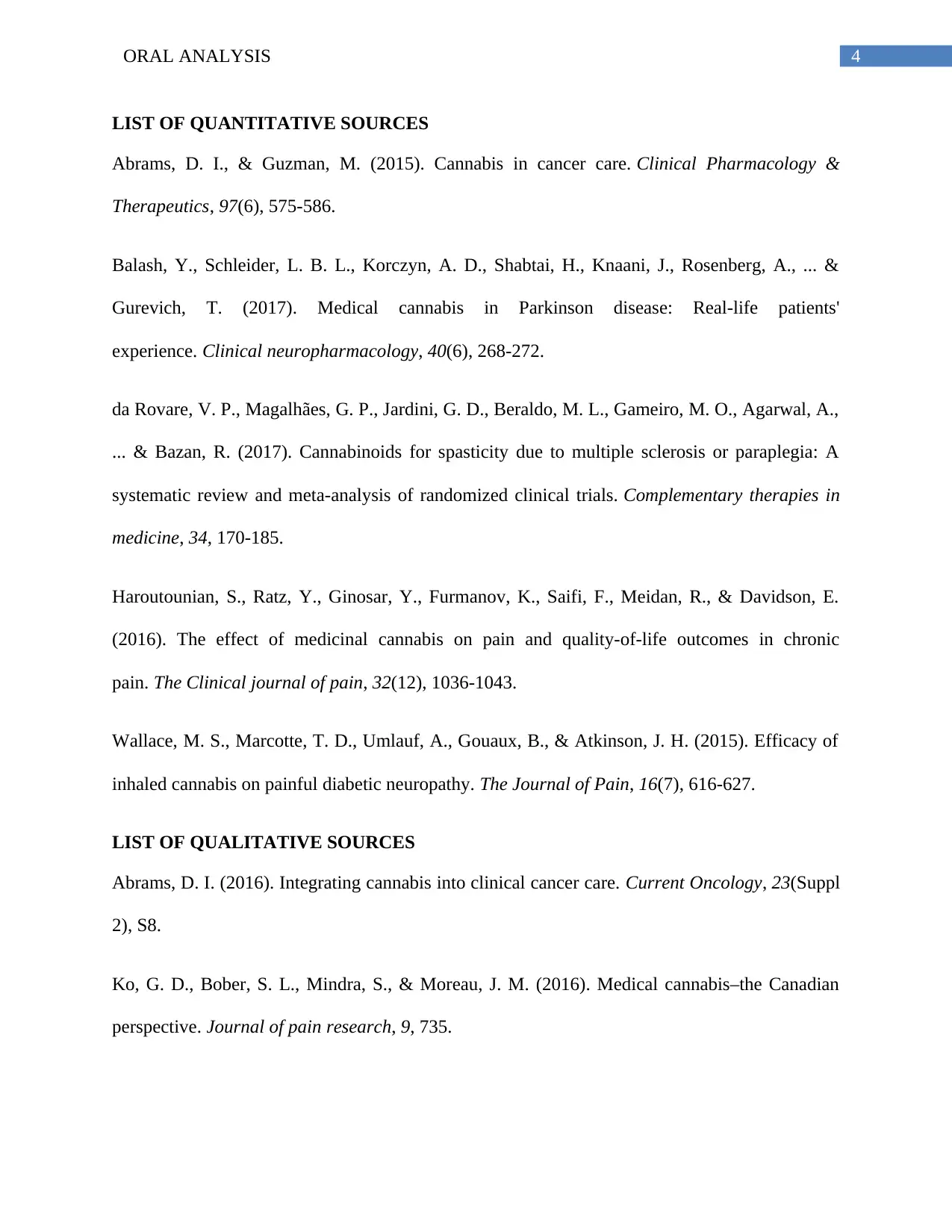
4ORAL ANALYSIS
LIST OF QUANTITATIVE SOURCES
Abrams, D. I., & Guzman, M. (2015). Cannabis in cancer care. Clinical Pharmacology &
Therapeutics, 97(6), 575-586.
Balash, Y., Schleider, L. B. L., Korczyn, A. D., Shabtai, H., Knaani, J., Rosenberg, A., ... &
Gurevich, T. (2017). Medical cannabis in Parkinson disease: Real-life patients'
experience. Clinical neuropharmacology, 40(6), 268-272.
da Rovare, V. P., Magalhães, G. P., Jardini, G. D., Beraldo, M. L., Gameiro, M. O., Agarwal, A.,
... & Bazan, R. (2017). Cannabinoids for spasticity due to multiple sclerosis or paraplegia: A
systematic review and meta-analysis of randomized clinical trials. Complementary therapies in
medicine, 34, 170-185.
Haroutounian, S., Ratz, Y., Ginosar, Y., Furmanov, K., Saifi, F., Meidan, R., & Davidson, E.
(2016). The effect of medicinal cannabis on pain and quality-of-life outcomes in chronic
pain. The Clinical journal of pain, 32(12), 1036-1043.
Wallace, M. S., Marcotte, T. D., Umlauf, A., Gouaux, B., & Atkinson, J. H. (2015). Efficacy of
inhaled cannabis on painful diabetic neuropathy. The Journal of Pain, 16(7), 616-627.
LIST OF QUALITATIVE SOURCES
Abrams, D. I. (2016). Integrating cannabis into clinical cancer care. Current Oncology, 23(Suppl
2), S8.
Ko, G. D., Bober, S. L., Mindra, S., & Moreau, J. M. (2016). Medical cannabis–the Canadian
perspective. Journal of pain research, 9, 735.
LIST OF QUANTITATIVE SOURCES
Abrams, D. I., & Guzman, M. (2015). Cannabis in cancer care. Clinical Pharmacology &
Therapeutics, 97(6), 575-586.
Balash, Y., Schleider, L. B. L., Korczyn, A. D., Shabtai, H., Knaani, J., Rosenberg, A., ... &
Gurevich, T. (2017). Medical cannabis in Parkinson disease: Real-life patients'
experience. Clinical neuropharmacology, 40(6), 268-272.
da Rovare, V. P., Magalhães, G. P., Jardini, G. D., Beraldo, M. L., Gameiro, M. O., Agarwal, A.,
... & Bazan, R. (2017). Cannabinoids for spasticity due to multiple sclerosis or paraplegia: A
systematic review and meta-analysis of randomized clinical trials. Complementary therapies in
medicine, 34, 170-185.
Haroutounian, S., Ratz, Y., Ginosar, Y., Furmanov, K., Saifi, F., Meidan, R., & Davidson, E.
(2016). The effect of medicinal cannabis on pain and quality-of-life outcomes in chronic
pain. The Clinical journal of pain, 32(12), 1036-1043.
Wallace, M. S., Marcotte, T. D., Umlauf, A., Gouaux, B., & Atkinson, J. H. (2015). Efficacy of
inhaled cannabis on painful diabetic neuropathy. The Journal of Pain, 16(7), 616-627.
LIST OF QUALITATIVE SOURCES
Abrams, D. I. (2016). Integrating cannabis into clinical cancer care. Current Oncology, 23(Suppl
2), S8.
Ko, G. D., Bober, S. L., Mindra, S., & Moreau, J. M. (2016). Medical cannabis–the Canadian
perspective. Journal of pain research, 9, 735.
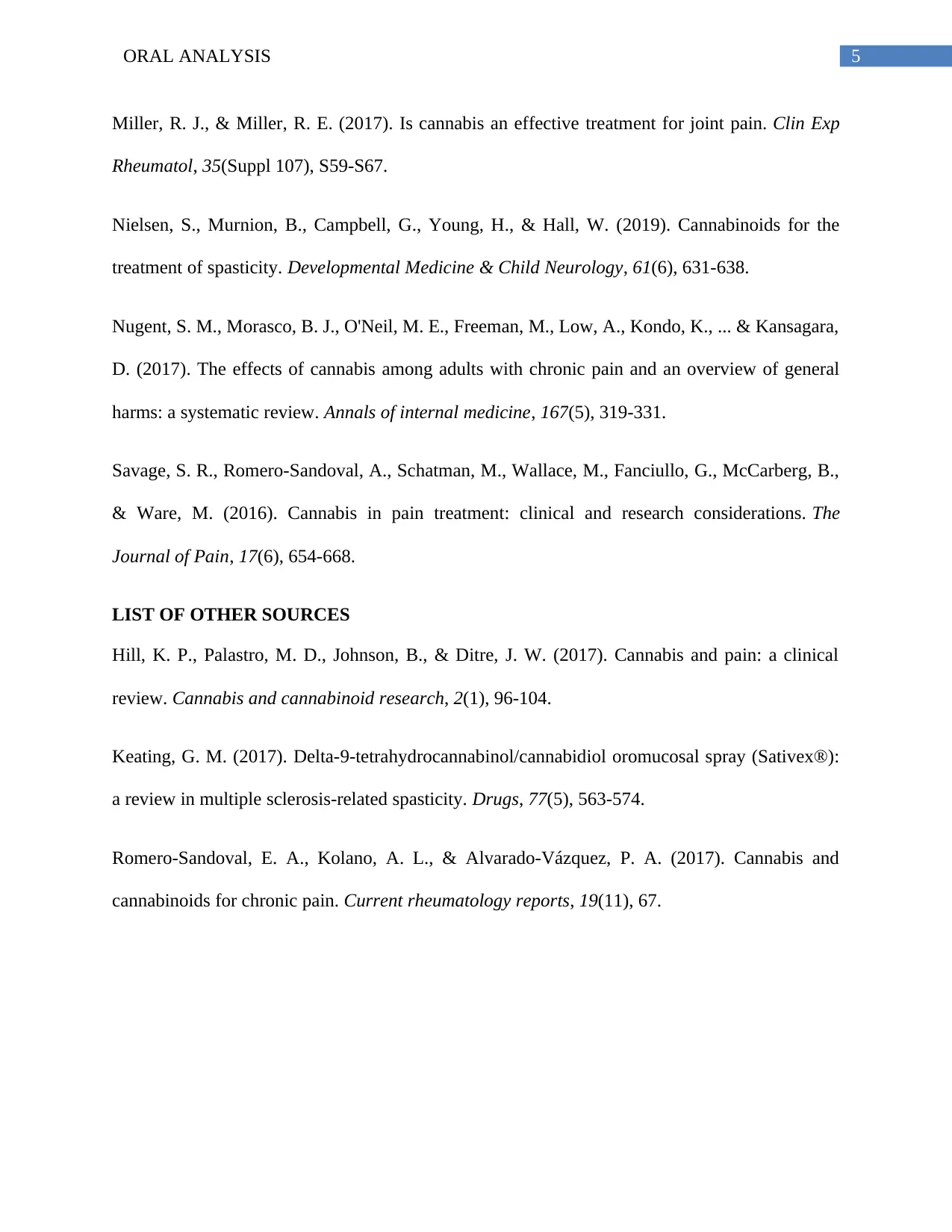
5ORAL ANALYSIS
Miller, R. J., & Miller, R. E. (2017). Is cannabis an effective treatment for joint pain. Clin Exp
Rheumatol, 35(Suppl 107), S59-S67.
Nielsen, S., Murnion, B., Campbell, G., Young, H., & Hall, W. (2019). Cannabinoids for the
treatment of spasticity. Developmental Medicine & Child Neurology, 61(6), 631-638.
Nugent, S. M., Morasco, B. J., O'Neil, M. E., Freeman, M., Low, A., Kondo, K., ... & Kansagara,
D. (2017). The effects of cannabis among adults with chronic pain and an overview of general
harms: a systematic review. Annals of internal medicine, 167(5), 319-331.
Savage, S. R., Romero-Sandoval, A., Schatman, M., Wallace, M., Fanciullo, G., McCarberg, B.,
& Ware, M. (2016). Cannabis in pain treatment: clinical and research considerations. The
Journal of Pain, 17(6), 654-668.
LIST OF OTHER SOURCES
Hill, K. P., Palastro, M. D., Johnson, B., & Ditre, J. W. (2017). Cannabis and pain: a clinical
review. Cannabis and cannabinoid research, 2(1), 96-104.
Keating, G. M. (2017). Delta-9-tetrahydrocannabinol/cannabidiol oromucosal spray (Sativex®):
a review in multiple sclerosis-related spasticity. Drugs, 77(5), 563-574.
Romero-Sandoval, E. A., Kolano, A. L., & Alvarado-Vázquez, P. A. (2017). Cannabis and
cannabinoids for chronic pain. Current rheumatology reports, 19(11), 67.
Miller, R. J., & Miller, R. E. (2017). Is cannabis an effective treatment for joint pain. Clin Exp
Rheumatol, 35(Suppl 107), S59-S67.
Nielsen, S., Murnion, B., Campbell, G., Young, H., & Hall, W. (2019). Cannabinoids for the
treatment of spasticity. Developmental Medicine & Child Neurology, 61(6), 631-638.
Nugent, S. M., Morasco, B. J., O'Neil, M. E., Freeman, M., Low, A., Kondo, K., ... & Kansagara,
D. (2017). The effects of cannabis among adults with chronic pain and an overview of general
harms: a systematic review. Annals of internal medicine, 167(5), 319-331.
Savage, S. R., Romero-Sandoval, A., Schatman, M., Wallace, M., Fanciullo, G., McCarberg, B.,
& Ware, M. (2016). Cannabis in pain treatment: clinical and research considerations. The
Journal of Pain, 17(6), 654-668.
LIST OF OTHER SOURCES
Hill, K. P., Palastro, M. D., Johnson, B., & Ditre, J. W. (2017). Cannabis and pain: a clinical
review. Cannabis and cannabinoid research, 2(1), 96-104.
Keating, G. M. (2017). Delta-9-tetrahydrocannabinol/cannabidiol oromucosal spray (Sativex®):
a review in multiple sclerosis-related spasticity. Drugs, 77(5), 563-574.
Romero-Sandoval, E. A., Kolano, A. L., & Alvarado-Vázquez, P. A. (2017). Cannabis and
cannabinoids for chronic pain. Current rheumatology reports, 19(11), 67.
⊘ This is a preview!⊘
Do you want full access?
Subscribe today to unlock all pages.

Trusted by 1+ million students worldwide
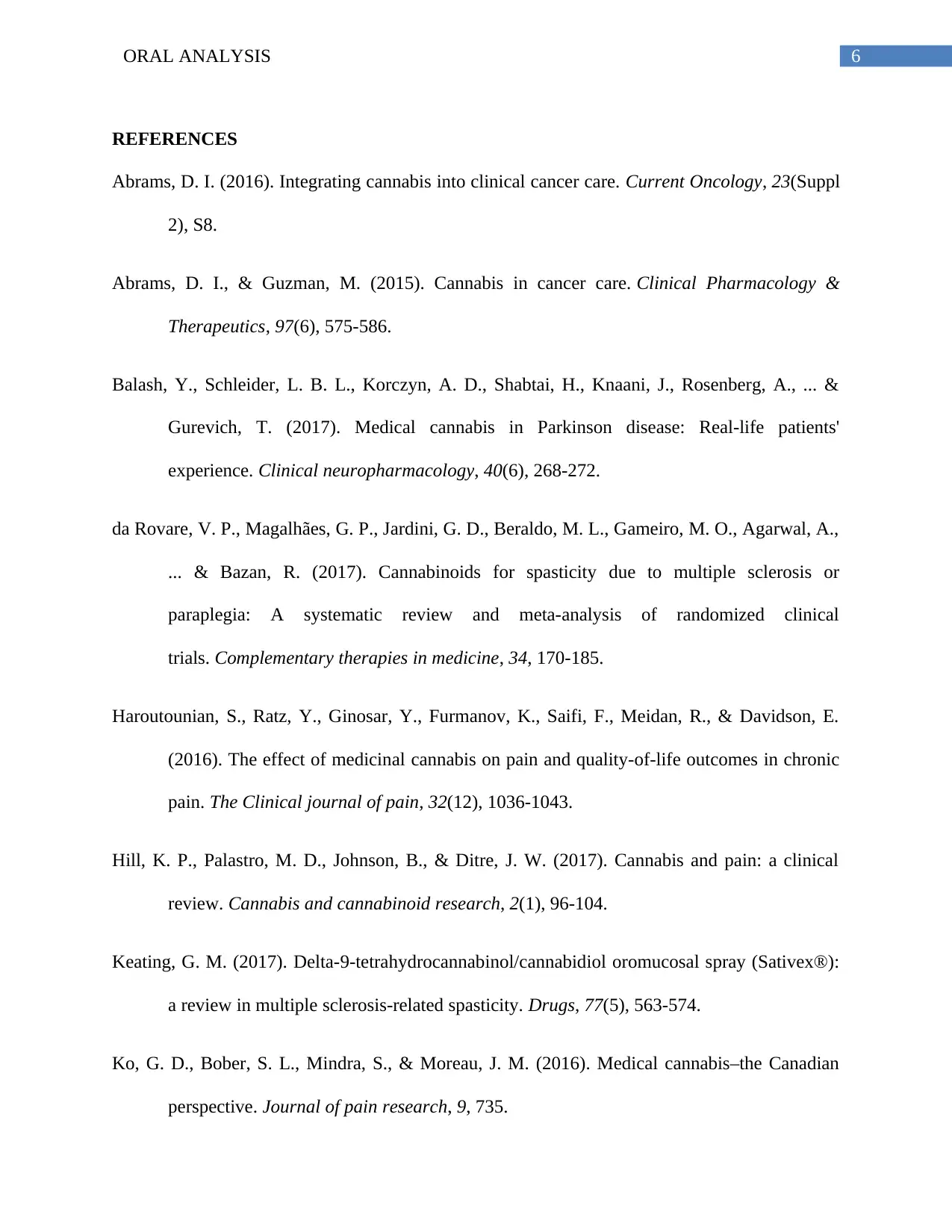
6ORAL ANALYSIS
REFERENCES
Abrams, D. I. (2016). Integrating cannabis into clinical cancer care. Current Oncology, 23(Suppl
2), S8.
Abrams, D. I., & Guzman, M. (2015). Cannabis in cancer care. Clinical Pharmacology &
Therapeutics, 97(6), 575-586.
Balash, Y., Schleider, L. B. L., Korczyn, A. D., Shabtai, H., Knaani, J., Rosenberg, A., ... &
Gurevich, T. (2017). Medical cannabis in Parkinson disease: Real-life patients'
experience. Clinical neuropharmacology, 40(6), 268-272.
da Rovare, V. P., Magalhães, G. P., Jardini, G. D., Beraldo, M. L., Gameiro, M. O., Agarwal, A.,
... & Bazan, R. (2017). Cannabinoids for spasticity due to multiple sclerosis or
paraplegia: A systematic review and meta-analysis of randomized clinical
trials. Complementary therapies in medicine, 34, 170-185.
Haroutounian, S., Ratz, Y., Ginosar, Y., Furmanov, K., Saifi, F., Meidan, R., & Davidson, E.
(2016). The effect of medicinal cannabis on pain and quality-of-life outcomes in chronic
pain. The Clinical journal of pain, 32(12), 1036-1043.
Hill, K. P., Palastro, M. D., Johnson, B., & Ditre, J. W. (2017). Cannabis and pain: a clinical
review. Cannabis and cannabinoid research, 2(1), 96-104.
Keating, G. M. (2017). Delta-9-tetrahydrocannabinol/cannabidiol oromucosal spray (Sativex®):
a review in multiple sclerosis-related spasticity. Drugs, 77(5), 563-574.
Ko, G. D., Bober, S. L., Mindra, S., & Moreau, J. M. (2016). Medical cannabis–the Canadian
perspective. Journal of pain research, 9, 735.
REFERENCES
Abrams, D. I. (2016). Integrating cannabis into clinical cancer care. Current Oncology, 23(Suppl
2), S8.
Abrams, D. I., & Guzman, M. (2015). Cannabis in cancer care. Clinical Pharmacology &
Therapeutics, 97(6), 575-586.
Balash, Y., Schleider, L. B. L., Korczyn, A. D., Shabtai, H., Knaani, J., Rosenberg, A., ... &
Gurevich, T. (2017). Medical cannabis in Parkinson disease: Real-life patients'
experience. Clinical neuropharmacology, 40(6), 268-272.
da Rovare, V. P., Magalhães, G. P., Jardini, G. D., Beraldo, M. L., Gameiro, M. O., Agarwal, A.,
... & Bazan, R. (2017). Cannabinoids for spasticity due to multiple sclerosis or
paraplegia: A systematic review and meta-analysis of randomized clinical
trials. Complementary therapies in medicine, 34, 170-185.
Haroutounian, S., Ratz, Y., Ginosar, Y., Furmanov, K., Saifi, F., Meidan, R., & Davidson, E.
(2016). The effect of medicinal cannabis on pain and quality-of-life outcomes in chronic
pain. The Clinical journal of pain, 32(12), 1036-1043.
Hill, K. P., Palastro, M. D., Johnson, B., & Ditre, J. W. (2017). Cannabis and pain: a clinical
review. Cannabis and cannabinoid research, 2(1), 96-104.
Keating, G. M. (2017). Delta-9-tetrahydrocannabinol/cannabidiol oromucosal spray (Sativex®):
a review in multiple sclerosis-related spasticity. Drugs, 77(5), 563-574.
Ko, G. D., Bober, S. L., Mindra, S., & Moreau, J. M. (2016). Medical cannabis–the Canadian
perspective. Journal of pain research, 9, 735.
Paraphrase This Document
Need a fresh take? Get an instant paraphrase of this document with our AI Paraphraser
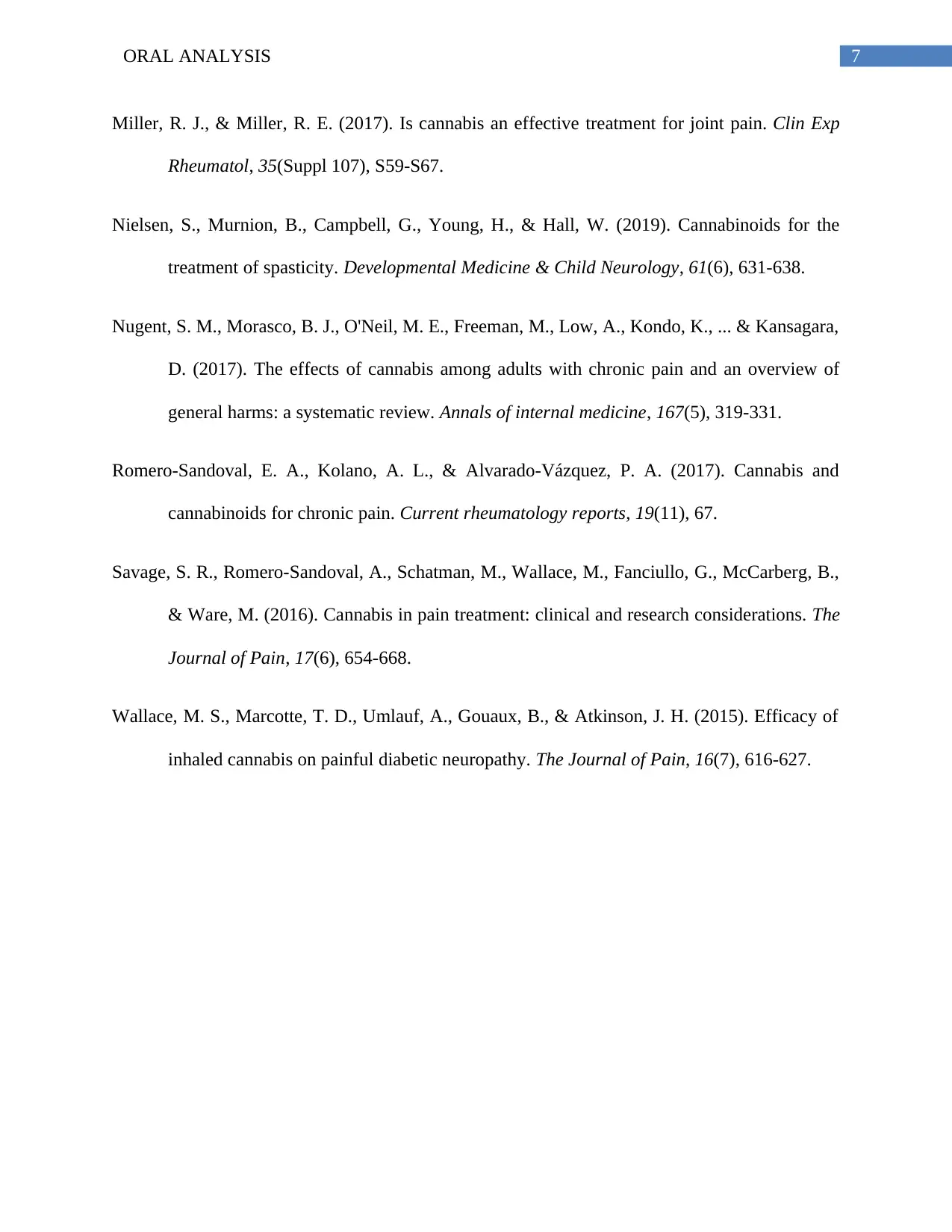
7ORAL ANALYSIS
Miller, R. J., & Miller, R. E. (2017). Is cannabis an effective treatment for joint pain. Clin Exp
Rheumatol, 35(Suppl 107), S59-S67.
Nielsen, S., Murnion, B., Campbell, G., Young, H., & Hall, W. (2019). Cannabinoids for the
treatment of spasticity. Developmental Medicine & Child Neurology, 61(6), 631-638.
Nugent, S. M., Morasco, B. J., O'Neil, M. E., Freeman, M., Low, A., Kondo, K., ... & Kansagara,
D. (2017). The effects of cannabis among adults with chronic pain and an overview of
general harms: a systematic review. Annals of internal medicine, 167(5), 319-331.
Romero-Sandoval, E. A., Kolano, A. L., & Alvarado-Vázquez, P. A. (2017). Cannabis and
cannabinoids for chronic pain. Current rheumatology reports, 19(11), 67.
Savage, S. R., Romero-Sandoval, A., Schatman, M., Wallace, M., Fanciullo, G., McCarberg, B.,
& Ware, M. (2016). Cannabis in pain treatment: clinical and research considerations. The
Journal of Pain, 17(6), 654-668.
Wallace, M. S., Marcotte, T. D., Umlauf, A., Gouaux, B., & Atkinson, J. H. (2015). Efficacy of
inhaled cannabis on painful diabetic neuropathy. The Journal of Pain, 16(7), 616-627.
Miller, R. J., & Miller, R. E. (2017). Is cannabis an effective treatment for joint pain. Clin Exp
Rheumatol, 35(Suppl 107), S59-S67.
Nielsen, S., Murnion, B., Campbell, G., Young, H., & Hall, W. (2019). Cannabinoids for the
treatment of spasticity. Developmental Medicine & Child Neurology, 61(6), 631-638.
Nugent, S. M., Morasco, B. J., O'Neil, M. E., Freeman, M., Low, A., Kondo, K., ... & Kansagara,
D. (2017). The effects of cannabis among adults with chronic pain and an overview of
general harms: a systematic review. Annals of internal medicine, 167(5), 319-331.
Romero-Sandoval, E. A., Kolano, A. L., & Alvarado-Vázquez, P. A. (2017). Cannabis and
cannabinoids for chronic pain. Current rheumatology reports, 19(11), 67.
Savage, S. R., Romero-Sandoval, A., Schatman, M., Wallace, M., Fanciullo, G., McCarberg, B.,
& Ware, M. (2016). Cannabis in pain treatment: clinical and research considerations. The
Journal of Pain, 17(6), 654-668.
Wallace, M. S., Marcotte, T. D., Umlauf, A., Gouaux, B., & Atkinson, J. H. (2015). Efficacy of
inhaled cannabis on painful diabetic neuropathy. The Journal of Pain, 16(7), 616-627.
1 out of 8
Your All-in-One AI-Powered Toolkit for Academic Success.
+13062052269
info@desklib.com
Available 24*7 on WhatsApp / Email
![[object Object]](/_next/static/media/star-bottom.7253800d.svg)
Unlock your academic potential
Copyright © 2020–2025 A2Z Services. All Rights Reserved. Developed and managed by ZUCOL.
